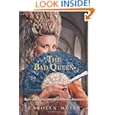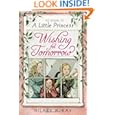What I've Read This Week: Part II
 The Bad Queen: Rules and Instructions for Marie-Antoinette (Young Royals) by Carolyn Meyer -- YA Historical Fiction
The Bad Queen: Rules and Instructions for Marie-Antoinette (Young Royals) by Carolyn Meyer -- YA Historical Fiction
Maria Antonia Josepha Johanna von Habsburg-Lothringen is the youngest daughter of Empress Maria Theresa of Austria. The Empress has many rules for Maria who will one day be the Queen of France. Maria chafes under the strict rules of her mother and does her best to ignore them when she can, but that becomes increasingly difficult after her betrothal to Prince Louis-Auguste of France. Upon her marriage to the dauphin, at the age of fourteen, Marie Antoinette, as she is now known, tries to do her best to follow the rules. For young Marie, life in the French court is vastly different from life back home in Austria. It is more elegant and elaborate, there is no privacy and there are enemies everywhere. Even worse is her husband, a young, awkward teenage boy with no interest in doing his duty to produce an heir to the throne. Marie struggles to win the affections of her husband, his grandfather and the rest of the court while still being true to herself. It's not always easy and sometimes a girl just has to break the rules to stay sane and happy. When the old King dies, Marie Antoinette finds herself in a position of wealth and power and is only too happy to promote her own interests away from the prying eyes of the court. She prefers to live a "simple" life in the country at her very own pleasure palace, the only place where she can truly be herself. This novel imagines Marie Antoinette's thoughts and feelings as she struggles to grow from young princess to adult Queen. Marie Antoinette tells her story through to their failed escape attempt and hands the quill over to her daughter who fills the reader in on her thoughts and feelings about the turmoil of the French Revolution. The author creates the perfect voice for Marie Antoinette: spoiled and naive but never cruel. She was a victim of the royal system: brought up to enjoy her position and wealth and taught nothing of the outside world. She was a young girl married to a young boy, neither of whom were competent enough to lead or understand why the peasants were so angry. I liked the little ways in which the dauphine tried to rebel and sort of felt sorry for her but she still comes across as an empty headed spoiled child even though she never actually said "Let them eat cake." This is a good addition to the Young Royals series and is written for a slightly older than the books about the Tudors. The writing is better than In Mozart's Shadow but perhaps not quite equal to her earliest books. Still, fans of Meyer's earlier works won't be disappointed in this one.
 Wishing for Tomorrow: The Sequel to A Little Princess by Hilary McKay and Nick Maland
Wishing for Tomorrow: The Sequel to A Little Princess by Hilary McKay and Nick MalandLife at Miss Minchin's school is dull and dreary until Sara Crewe arrives. The little girls, led by Lottie, are fascinated by Sara's stories and Ermengarde finds a friend for the first time. Then Sarah loses all her material possessions and is banished to the attic, but never stops acting like a princess. Ermengarde treasures Sara's friendship while being secretly jealous of Sara's growing friendship with Becky. When the magic comes, Ermengarde hopes Sara will share, but then Sara goes away with the Indian gentleman and life at Miss Minchin's becomes more unbearable than ever. Miss Minchin's health rapidly declines, Lottie becomes even more unruly, Lavinia develops a passion for learning thanks to their new neighbor, and poor Ermengarde is even more lonely than ever. Presiding over the school is Alice, the new maid from the country, with strange ideas about the benefits of fresh air and teaching children to work. Meanwhile, Sara and Becky are enjoying themselves by the seaside. Sara sends letters and gifts back to the school, but Ermengarde remains miserable and writes letters to Sara that she never sends. It takes an unexpected visitor and a serious crisis for Ermengarde to realize how selfish she has been. This is a slow moving companion to the lovely early 20th century classic. The first half of the book simply recounts the events of the original before continuing on with what happens next. There isn't much plot, just a series of endless, repetitive days wherein Ermengarde sulks, Lottie behaves badly and Lavinia teaches herself something new. The characterization is also rather weak. The characters don't really grow, they just sort of exist as flat, two-dimensional stereotypes of adolescent girls. I had hoped to see what happens next for Sara and Becky, but they only appear in letters and briefly at the end. The illustrations are too modern in style for a Victorian book and didn't add anything to the story. I would skip this book if you're a fan of the original.

No comments:
Post a Comment
Leave comments and or suggestions for QNPoohBear, the modern bluestocking.